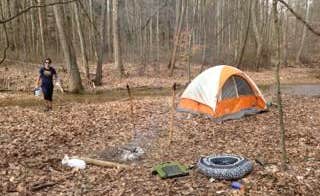Dispersed camping opportunities near Garrett, Kentucky offer primitive wilderness experiences on federal lands across southeastern Kentucky and southern Indiana. The region sits at elevations between 600-1,000 feet with limestone karst formations creating distinctive terrain features throughout surrounding forests. Most sites require navigating unpaved roads that become challenging during wet weather conditions and generally lack designated facilities.
What to do
Explore fossil-rich creek beds: The Knobstone Trail features numerous creek crossings where hikers can observe fossils embedded in limestone. "There are lovely vistas and lots of fossils on the trail and creek beds," reports Maris H., who recommends planning your hike carefully as "you're never too far from water, although the quality may differ depending on the time of year."
Navigate backroads to secluded sites: Finding camping spots along Mitchell Creek Road Dispersed requires patience and careful navigation. Phil L. explains, "There are just a couple of sites along the road. One is at the trail crossing for horses, hikers, and bikers. Its basically a make your own campsite." Plan for self-sufficient camping without facilities.
Star-gaze in true darkness: The remote locations provide exceptional night sky viewing opportunities away from light pollution. Minimal vehicle traffic contributes to the isolation, with campers noting the profound quiet. The dense forest canopy opens to clear night skies during fall and winter months when foliage thins.
What campers like
Complete solitude: The remoteness of sites provides exceptional isolation. At Jackson Trailhead, campers appreciate the privacy after navigating rough terrain. "There's parking after a decrepit gravel road and suitable for camping. There are campsites along the trail just have to find them," notes loganx11.
Challenging terrain: The region offers strenuous hiking conditions that appeal to experienced backpackers. "The KT earns its nickname 'little AT'," writes Maris H. about Knobstone Trail, explaining, "The KT is rugged and has lots of elevation gains over short distances." Dave E. confirms, "It's no walk in the park. There are continuous ups and downs that will challenge your leg strength and footing at times."
Wildlife encounters: The undeveloped nature of the camping areas creates opportunities for animal sightings. Campers report seeing turtles on roads and hearing coyotes at night. Jaymi A. describes camping at Mitchell Creek Road as "quiet, secluded, and beautiful" where during a 16-hour stay "only two vehicles passed during the entire time."
What you should know
Limited phone service: Communication devices typically fail throughout the region. Jaymi A. advises, "Have a paper map handy, as there is no cell signal and GPS was spotty." This applies to nearly all dispersed camping areas within 60 miles of Garrett.
Water availability varies seasonally: Streams that flow heavily in spring often diminish or disappear completely during summer and fall. Dave E. notes about Hoosier National Forest, "Water can become scarce in the summer/fall months, but if you walk far enough, you're likely to come by a stream of some sort."
Road conditions restrict access: Many sites become inaccessible after rain. Sabrina C. reports about Mitchell Creek Road, "Road south coming in was destroyed some time ago have to w yer from east or west road." Jaymi A. adds, "A few of the pull offs I didn't explore because they were muddy or washed out after several days of rain."
Tips for camping with families
Choose accessible locations: Some areas near Garrett are more family-friendly than others. Susan C. recommends developed areas near Knobstone Trail: "The entire park is just beautiful. It's very family friendly and quiet. The sites are spacious, and there are a lot of nature things to do."
Prepare for insects: Ticks and mosquitoes are prevalent, particularly during warm months. "Watch out for ticks. My dogs and I got loads of them in April 2020 from Leota to Spurgeon Hollow," warns Maris H. Pack appropriate repellents and conduct regular tick checks.
Plan for terrain challenges: The elevation changes can be difficult for younger children. Many access points require navigating steep terrain that becomes slippery when wet, potentially creating hazardous conditions for inexperienced hikers.
Tips from RVers
Size limitations are severe: Most dispersed camping areas near Garrett cannot accommodate recreational vehicles. Jaymi A. explains about Mitchell Creek Road, "I did not see any pull offs that would accommodate an RV of any size, and nothing large enough to turn a trailer around. One pull off was nearly too small to turn around my small pick up truck."
Consider alternatives: RV campers should focus on established campgrounds rather than dispersed sites. Sofia A. describes her experience at Mitchell Creek Road: "After 5 min of driving on the very skinny gravel road y saw what it look like spots but Iam not sure really... Y just keep driving till I got back to 64 and found a Cracker Barrel 17 miles away."


